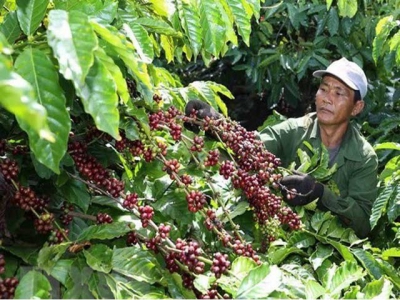Coffee exporters count on local market as exports slow

A farmer harvests coffee. Many Vietnamese coffee processing and exporting enterprises have yet to develop their brands - PHOTO: VNA
HANOI – Vietnamese coffee exporters are seeking opportunities in the domestic market, as they are facing reduced exports due to falling prices.
According to the Ministry of Agriculture and Rural Development, coffee in the Central Highlands was priced at VND31,900-32,500 per kilogram last month, down VND700 month-on-month. In the January-September period, domestic coffee prices plunged by VND2,100-2,400 per kilogram.
Meanwhile, the global export price of coffee averaged some US$1,900 per ton between January and August, a year-on-year decline of 15.5%.
At present, the global market is facing an oversupply of coffee, as demand remains low.
Major coffee exporting countries, such as Brazil, Colombia, India and Indonesia, have had bumper crops, while Vietnamese farmers will harvest coffee in the next few weeks, thus intensifying the oversupply.
In addition, the U.S. Federal Reserve has raised interest rates, resulting in the U.S. dollar becoming stronger than other currencies, eroding the competitiveness of Vietnam's coffee exports. In addition, many Vietnamese coffee processing and exporting enterprises have yet to develop their brands, making it difficult for them to penetrate global markets.
Therefore, numerous coffee exporters have shifted to exploiting the domestic market. However, it is not an easy job, said Phan Minh Thong, chairman and general director of Phuc Sinh Company, an exporter of coffee and pepper, which reported revenues of US$300 million last year.
Although Phuc Sinh has launched many coffee products in the Vietnamese market over the past two years, its revenues from the domestic market account for a small proportion of its total revenues.
Thong said Phuc Sinh annually exports some 65,000-70,000 tons of coffee, while its coffee sales in Vietnam are equal to only 1% of outbound sales, and the company is suffering losses in its domestic sales.
At a recent press conference, Nguyen Quoc Toan, acting director of the Agro Processing and Market Development Authority under the Ministry of Agriculture and Rural Development, recommended local coffee processing and exporting firms boost their connectivity and develop their brands, in a bid to cope with global price volatility.
In reality, the ministry has issued multiple solutions to build value chains to enhance coffee exports and local consumption. However, the number of enterprises successfully shifting to the domestic market remains modest.
According to the Ministry of Agriculture and Rural Development, the country exported 1.46 million tons of coffee through September 2018, valued at US$2.77 billion, up 20.1% in volume and 0.4% in value over last year.
Germany and the United States were Vietnam’s largest coffee buyers in the January-August period, accounting for 12.6% and 9.8%, respectively. Meanwhile, shipments to Indonesia, Russia and the Philippines reported high growth rates at between 46.6% and 66.6%.
Có thể bạn quan tâm
 Dragon fruit prices hit rock bottom
Dragon fruit prices hit rock bottom The price of dragon fruit in the central province of Bình Thuận, the country’s largest producer of the crop, has fallen significantly in the last two weeks.
 Fruit, veggie exports likely to hit US$3.8 billion
Fruit, veggie exports likely to hit US$3.8 billion Vietnam is projected to earn US$3.1 billion in vegetable and fruit exports in the first nine months of the year, a year-on-year surge of 17.1%.
 Blockchain technology: The 'passport' for agricultural exports to major markets
Blockchain technology: The 'passport' for agricultural exports to major markets A tracing system based on blockchain technology provides consumers with information from production to consumption, all of which is done in real time.